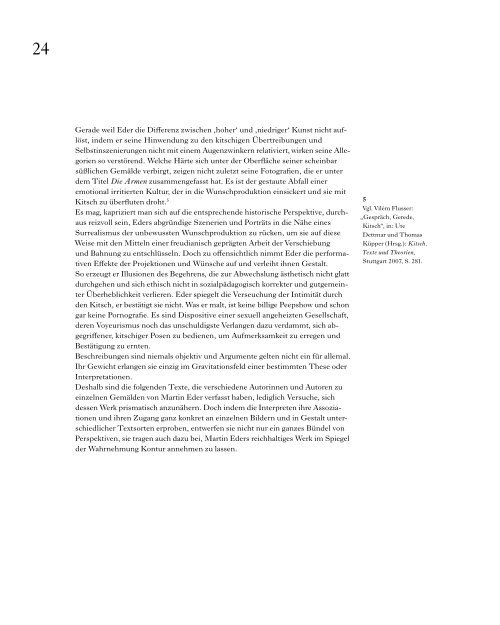download - Galerie EIGEN+ART
download - Galerie EIGEN+ART
download - Galerie EIGEN+ART
Erfolgreiche ePaper selbst erstellen
Machen Sie aus Ihren PDF Publikationen ein blätterbares Flipbook mit unserer einzigartigen Google optimierten e-Paper Software.
24<br />
Gerade weil Eder die Differenz zwischen ,hoher‘ und ,niedriger‘ Kunst nicht auf-<br />
löst, indem er seine Hinwendung zu den kitschigen Übertreibungen und<br />
Selbstinszenierungen nicht mit einem Augenzwinkern relativiert, wirken seine Alle-<br />
gorien so verstörend. Welche Härte sich unter der Oberfläche seiner scheinbar<br />
süßlichen Gemälde verbirgt, zeigen nicht zuletzt seine Fotografien, die er unter<br />
dem Titel Die Armen zusammengefasst hat. Es ist der gestaute Abfall einer<br />
emotional irritierten Kultur, der in die Wunschproduktion einsickert und sie mit<br />
Kitsch zu überfluten droht. 5<br />
Es mag, kapriziert man sich auf die entsprechende historische Perspektive, durch-<br />
aus reizvoll sein, Eders abgründige Szenerien und Porträts in die Nähe eines<br />
Surrealismus der unbewussten Wunschproduktion zu rücken, um sie auf diese<br />
Weise mit den Mitteln einer freudianisch geprägten Arbeit der Verschiebung<br />
und Bahnung zu entschlüsseln. Doch zu offensichtlich nimmt Eder die performa-<br />
tiven Effekte der Projektionen und Wünsche auf und verleiht ihnen Gestalt.<br />
So erzeugt er Illusionen des Begehrens, die zur Abwechslung ästhetisch nicht glatt<br />
durchgehen und sich ethisch nicht in sozialpädagogisch korrekter und gutgemeinter<br />
Überheblichkeit verlieren. Eder spiegelt die Verseuchung der Intimität durch<br />
den Kitsch, er bestätigt sie nicht. Was er malt, ist keine billige Peepshow und schon<br />
gar keine Pornografie. Es sind Dispositive einer sexuell angeheizten Gesellschaft,<br />
deren Voyeurismus noch das unschuldigste Verlangen dazu verdammt, sich ab-<br />
gegriffener, kitschiger Posen zu bedienen, um Aufmerksamkeit zu erregen und<br />
Bestätigung zu ernten.<br />
Beschreibungen sind niemals objektiv und Argumente gelten nicht ein für allemal.<br />
Ihr Gewicht erlangen sie einzig im Gravitationsfeld einer bestimmten These oder<br />
Interpretationen.<br />
Deshalb sind die folgenden Texte, die verschiedene Autorinnen und Autoren zu<br />
einzelnen Gemälden von Martin Eder verfasst haben, lediglich Versuche, sich<br />
dessen Werk prismatisch anzunähern. Doch indem die Interpreten ihre Assoziatio<br />
nen und ihren Zugang ganz konkret an einzelnen Bildern und in Gestalt unterschiedlicher<br />
Textsorten erproben, entwerfen sie nicht nur ein ganzes Bündel von<br />
Perspektiven, sie tragen auch dazu bei, Martin Eders reichhaltiges Werk im Spiegel<br />
der Wahrnehmung Kontur annehmen zu lassen.<br />
5<br />
Vgl. Vilém Flusser:<br />
„Gespräch, Gerede,<br />
Kitsch“, in: Ute<br />
Dettmar und Thomas<br />
Küpper (Hrsg.): Kitsch.<br />
Texte und Theorien,<br />
Stuttgart 2007, S. 281.<br />
There is no correct pose in a wrong negligee<br />
Martin Eder, desire and<br />
the omnipresence of kitsch<br />
“ My paintings are actually battle scenes.<br />
They are full of murder and they are incredibly bloodthirsty.”<br />
Martin Eder1 The motifs in Martin Eder’s paintings have been quick to give them a centre of<br />
gravity in public perception. This centre has placed them in a stable orbit – that of<br />
kitsch. At first glance, the figures that populate his paintings seem to support this –<br />
often, they are naked young women in poses that are melancholic and languorous,<br />
yet lascivious at the same time; and there are plenty of over-sweet, fluffy white<br />
kittens. This kind of arrangement fits in well with the success story of contemporary<br />
art. ‘Culture – kitsch – commerce’ is the alliterative phrase that seems to<br />
sum it up. As if on a hermeneutic slide, romantically made-up figures frequently<br />
seem to slither down the precipitous slope from high art to the trivial.<br />
But kitsch is neither a homogenous, precisely defined concept, nor is it the only synonym<br />
for bad taste. The trashy and the drastic provide competition for kitsch here<br />
and there, and even the camp – as an ironical variation of a manner of experience 2<br />
based on tricks and exaggeration – appears to have come back up out of the archives<br />
and returned to the stage. All these are ways of behaving in response to an increasingly<br />
heterogeneous and sexually charged collective world of emotions – emotions<br />
that are dominated by self-promotion and the demand for attention, the adulation<br />
of prominent people, and the cloning of gestures that seem to ensure success. They<br />
exist in this form as a result of the return to an increasingly global culture of taste,<br />
which cares nothing for historical or physical motifs and dispositions. Nothing holds<br />
the current mixture of revivals and evergreens, of success, longing for glory, and<br />
the profit motive together as surely as personal taste. Everybody thinks they have it,<br />
in one form or another, yet nowadays no-one has to be ashamed of it. No matter how<br />
heterogeneous art becomes, no matter how warmed-over or decorative it appears,<br />
taste will make it acceptable. Anything is beautiful if somebody likes it – and is prepared<br />
to buy it.<br />
Marcel Duchamp – who, like no other, led a nonchalant and ironical battle against<br />
the notion of taste – had a different definition. As early as 1949, he said in an interview<br />
that taste 3 “creates a sensual feeling, not an aesthetic emotion. Taste works on<br />
the assumption that there is one dominant observer who dictates what he does and<br />
doesn’t like, and translates that into ‘beautiful’ and ‘ugly.’” It’s that simple. Duchamp<br />
continued: “It is quite different for a ‘victim’ of an ‘aesthetic echo’ – he is in a<br />
po sition like that of a man in love, or a religious believer, who automatically gives up<br />
his demanding ego and surrenders helplessly to a delightful and mysterious force…<br />
My personal conclusion from this is that, generally speaking, very few people are<br />
capable of feeling an aesthetic emotion or sensing an ‘aesthetic echo.’ While many<br />
people have taste, only a small number are equipped with aesthetic receptivity.” 4<br />
1<br />
Martin Eder in an interview<br />
with Thomas<br />
Wagner: “Über Illu-<br />
sionen, Faustschläge und<br />
Zeitkonten”, in: <strong>Galerie</strong><br />
EIGEN + ART (Ed.):<br />
Martin Eder. Silbern<br />
weint ein Krankes, Berlin<br />
2007, p. 11.<br />
2<br />
cf. Susan Sontag, ‘An-<br />
merkungen zu “Camp”’,<br />
in: Kunst und Antikunst,<br />
Munich / Vienna 1980,<br />
pp. 269–284.<br />
3<br />
Marcel Duchamp,<br />
Interviews und Statements,<br />
Stuttgart 1992,<br />
p. 39.<br />
4<br />
Duchamp, ibid.



